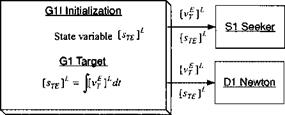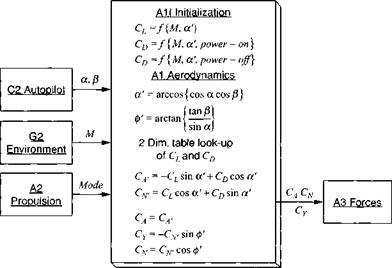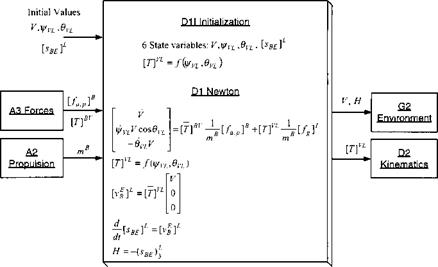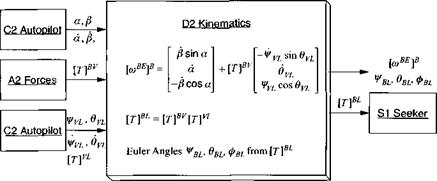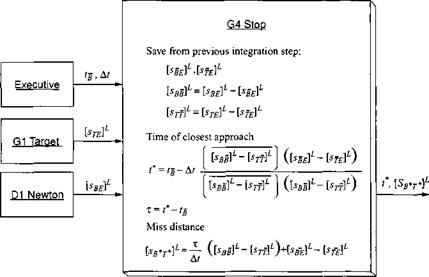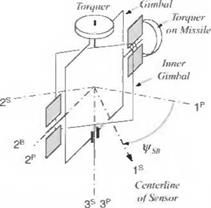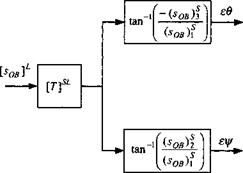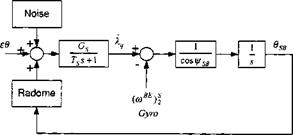CRUISES—Cruise Missile
Cruise missiles fly like autonomously controlled airplanes, but do not return, unless used as reconnaissance vehicles. The CRUISE5 simulation is representative of these types of vehicles. Figure 9.55 shows the modular structure and the calling sequence. During the cruise phase, the missile navigates with GPS/INS from way – point to waypoint until it reaches the terminal area. Now the sensor, pointed by the INS at the target, becomes active and provides the refined navigation solution to the line guidance law. The autopilot converts the acceleration commands into bank-to-turn steering signals, which the airframe executes until impact.
I will be brief with the description of the modules in the hope that you have gained enough savvy to explore on your own the source code provided on the CADAC CD.
The G1 Target Module models a simple point target, possibly moving along a straight line.
The G2 Environmental Module uses the ARDC 1959 standard atmosphere, and an option is provided for the tabular input of a special atmosphere. Wind and gust effects are modeled in a simplified manner.
The A1 Aerodynamic Module provides the lift and drag coefficients as functions of Mach and angle of attack for three c. m. locations. With an aspect ratio of 20, best lift-over-drag value is about 10. Span is 4.3 m and reference area = 0.929 m2. Refer to Sec. 9.2.1.2 for more detail.
The A2 Propulsion Module gives the thrust available (max thrust) and idle thrust (min thrust) as provided by tables as a function of altitude and Mach number. Given the thrust, the fuel flow rate is obtained from tables, which depend on thrust and altitude. A Mach hold controller maintains the cruise speed. The modeling of the turbojet is discussed in Sec. 9.2.2. Takeoff gross mass is 1019 kg, and maximum fuel mass is 195 kg.
|
Fig. 9.56 GPS constellation. |
The S2 GPS Module consists of four GPS satellites and a 17 states Kalman filter that updates the INS navigation solution. Figure 9.56 shows the satellite constellation. Because the CRUISE5 simulation uses the flat-Earth assumption, the Earth is nonrotating, and the satellites have to be assumed fixed. Although unrealistic, this simplification is acceptable for short duration flights and for generic navigation error studies. However, it is unsuitable for flight-test support.
My discussion of GPS and its filter is very abbreviated because it would lead us too far into an advanced topic that is well covered in the literature.24 For those of you who have the drive and motivation, a solid foundation in GPS navigation together with the following diagrams should be sufficient to help you interpret the FORTRAN code of the S2 Module.
Based on the satellite and cruise-missile geometry of Fig. 9.56, there are five dilution of precision calculations that are summarized in Fig. 9.57. The pseudorange measurements are corrupted by ionospheric and tropospheric effects, and additional errors are introduced by path delays, receiver noise and resolution, receiver dynamic noise, clock bias, and clock frequency uncertainties. These errors corrupt the measurements that are input to the Kalman filter as shown in Fig. 9.58.
The Kalman filter consists of 17 states that model nine INS errors and eight instrument uncertainties (three INS positions, three INS velocities, three INS tilts, three INS accelerometer biases, three INS gyro biases, one clock bias, one clock frequency error). Figure 9.59 shows the linear dynamic F matrix with the specific force coupling terms f, /2, and /3, the direction cosine matrix [TBL, and the clock time constant rc.
Finally, Fig. 9.60 combines all the elements into the sequence of the filtering process. As in any Kalman filter, there is an extrapolation and update phase. The update of the states is sent to the INS, its sensors, and the GPS clock. A typical update rate is 1 Hz. Although the equations have the appearance of a linear filter, in effect the measurements are nonlinear, and therefore we are modeling an extended Kalman filter that linearizes the observation matrix at every integration step.
Unless you are a control engineer, these diagrams may overwhelm you. Get a good grip of Kalman filtering through books like that by Maybeck.25 Then with
perseverance, you should be able to back out the equations from the FORTRAN code. After a series of test cases, you may feel like you have mastered the subject.
The SI Sensor Module can detect and image a landmark or target and update, just like GPS, the INS navigation solution. Although the sensor is a simple kinematic model, it has a full set of errors that corrupt the true LOS. The measurement is sent to the INS in raw form without filtering to keep the implementation lucid. Several fixes can occur on one image improving the update consecutively.
To understand the update process, we first define miss distance as the vectorial sum of guidance and navigation errors (see Fig. 9.61). The navigation error is the
distance between the true and estimated position of the target, and the guidance error encompasses the remaining vehicle errors, originating from the guidance law, the autopilot, air-frame maneuver limits, and environmental effects.
Figure 9.62 depicts the two steps of seeker measurement and navigation update. In preparation of the measurement, the INS points the seeker at f, but the seeker pointing error instead misplaces the beam at point A, the aimpoint. The scene is imaged and the measured update determined. The measured update corrects the navigation error except for the inherent pointing error.
Before the navigation update the scene is correlated with the stored template, but unfortunately a correlation error creeps in that corrupts the measured update. Now the processor updates the estimated target location from T~ to T+. The original navigation error is reduced by the measured update, except for the correlation error. The vehicle executes a correction and flies towards the new target point
f+.
The S4 INS Module is tightly integrated into the GPS and sensor loop. It stabilizes the GPS algorithms and points the sensor beam at the target. Its navigation solution is updated either by GPS in absolute coordinates or by the sensor in target – relative coordinates. It presents the single interface to the guidance processor. As in the SRAAM5 simulation, the nine error state equations (three positions, three
|
*3×1 |
position error |
velocities, and three tilts) bring realism to the fly-out accuracy. The derivation of the error equations can be found in Sec. 10.2.4.
The Cl Guidance Module converts the navigation information from the INS to pitch acceleration and bank-angle commands that are executed by the control module. Three options are provided: waypoint guidance, terrain following/obstacle avoidance (TF/OA), and terminal line guidance. For course planning waypoints are identified on the map, and the cruise missile follows the sequence along preset headings, employing the lateral line guidance law as outlined in Sec. 9.2.4. In the vertical plane either the altitude hold loop of the Control Module C2 is engaged, or the TF/OA guidance law is invoked. As the missile approaches the terminal area, line guidance steers the missile in both planes to the target.
Obstacles are generated by two stochastic functions. An exponential distribution determines the waiting distance for the next obstacle to occur. The height of the obstacles is determined by a Rayleigh distribution. Terrain roughness is provided by the Newton Module Dl. The onboard sensor can track terrain and obstacles either in a look-down or look-ahead mode. The look-ahead mode assumes that a terrain database of the area has been loaded in the guidance processor.
The C2 Control Module provides several autopilot options. Although a skid-to – turn mode is also given, we make use only of the bank-to-tum option. The key features are the acceleration controllers and the altitude hold autopilot. Both types are discussed in Sec. 9.2.3. The heading and flight-path-angle controllers are of lesser significance.
|
Fig. 9.60 Kalman filter propagation and update equations. |
The A3 Forces Module is where the aerodynamic and propulsive forces combines and sends them as specific forces to the INS and Newton Modules. The TM [THV is also calculated from Eq. (9.11).
The D1 Newton Module’s primary purpose is to solve the translational equations of motion. It also contains a subroutine that generates stochastic terrain, compatible for a look-down or look-ahead terrain sensor. The stochastic model is a second – order autocorrelation function driven by white Gaussian noise. The parameters of Table 9.3 describe the roughness of the terrain at three typical locations.
|
Table 9.3 Typical terrain of three levels of roughness
|
The D2 Rotation Module replaces the Euler equations of six-DoF simulations. Its main output is the body rate coBE]B for the INS module and the direction cosine matrix [T]BL for various transformation tasks.
The G4 Impact Module computes the waypoint and target miss distances are computed. As defined in Fig. 9.61, the navigation and guidance errors that make up the miss distance are also recorded. The target, specified by a point, is a surface, which is oriented relative to Earth by two angles. The equations for the miss distance in the target plane are taken from Problem 2.8.
We have completed the round through the modules of Fig. 9.55. It is now up to you to exercise the test cases provided on the CAD AC CD. Particularly interesting is the study of maneuver requirements for various terrain roughness. Figure 9.63 shows a typical trajectory plot of the CRUISE5 vehicle, hugging a medium-rough terrain at an average clearance of 50 m while avoiding obstacles placed on the surface. Well, CRUISE5 did hit an obstacle, placed at a very inopportune location, just as it descended into a valley. Assuming it survived intact, it pops up, and then dives into the target under line guidance.
Pseudo-five-DoF simulations take an important place in the arsenal of an aerospace engineer. They are easier to build than six-DoF simulations, and, in contrast to three-DoFs, model attitude dynamics, although simplified. During the preliminary design phase, they serve to establish the performance of the vehicle. With the maturing of the concept, however, more information becomes available, especially in aerodynamics and autopilot design. Now the construction of a six-DoF model can begin. The next chapter provides the details.
|
Fig. 9.61 Miss distance definition. |
1. Seeker Measurement
 |
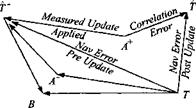
 |
f
Problems
9.1 AIMS engagement studies. Investigate the performance of the AIM5 air – to-air missile as modeled by the CAD AC AIM5 simulation. Performance is defined in terms of launch envelope and miss distance. The missile’s fly-out time is limited by the onboard battery life of 30 s.
Task 1: Download the AIM5 project from the CADAC CD and run the test
cases INHORI. ASC, INHOR3.ASC, and INVERT3.ASC. Get familiar with the AIM5 documentation of Sec. 9.3.1.
Task 2: Analyze the performance of the AIM5 missile using the CADAC SWEEP methodology. Set up input files for the following engagement codes taken from Tables P9.1 and P9.2:
|
Input file |
Codes |
|
INLOW. ASC |
Ll/Tl |
|
INMED. ASC |
L2/T2 |
|
INHIGH. ASC |
L3/T3 |
|
INMIX. ASC |
L1/T2 |
Run the four SWEEP cases by setting up fans with varying launch ranges DHTB and angles AZTLX. Contour the launch envelopes, limited by miss distance not greater than 5 m and flight time not greater than 30 s.
Task 3: Document your results. Provide your four input files and four contour
plots.
9.2 Automatic approach to LAX with Falcon aircraft. Using CRUISE5 as a template, build a pseudo-five-DoF simulation of an aircraft with the following module structure (you have to change only the shaded Modules A1 and A2).
Task 1: Familiarize yourself with the CRUISE5 simulation, run the test cases, and plot selected parameters.
Task 2: Strip CRUISE5 of unnecessary modules and run test cases
INCRUISE. ASC, INCLIMB. ASC, and INIP. ASC for verification.
Task 3: Download from the CADAC CD the FALCON5 aerodynamics and propulsion data decks and create the new Modules A1 and A2.
Task4: Adopt the test cases INCRUISE. ASC, INCLIMB. ASC, and INIP. ASC to the FALCON5 simulation and execute them for verification. (You may have to tweak the autopilot.)
|
Table P9.1 Missile launch conditions
|
Table P9.2 Target aircraft conditions at time of
missile launch
|
Target conditions |
Altitude, m |
Mach |
Heading deg |
|
T1 |
1000 |
0.6 |
180 |
|
T2 |
3000 |
0.75 |
180 |
|
T3 |
5000 |
0.9 |
90 |
Task 5: Guide your FALCON5 to an automatic landing approach at L. A. International Airport, Runway 076 deg at 34°27’N, 118°26’W (start of runway). Begin over Santa Catalina Island, 33°50’N, 118°025’W, heading 300 deg, speed 164 m/s, altitude 3000 m. Approach IP (500 m before start of runway) at heading 76 deg and glide slope—10 deg with Mach 0.3 and flaps out (20% increase in drag, 60% increase in lift).
(a) Build the input file INLAX. ASC. Consider inserting an additional waypoint. Bring the aircraft down in altitude steps at 20 km from the IP with extended flaps.
(b) Display the three-dimensional trajectory in KPLOT-РГГА with time traces of altitude, Mach number, flight-path angle, and heading angle.
9.3 AGM5 air-to-ground missile. Convert the AIM5 air-to-air missile model into an unpropelled air-to-ground missile simulation and determine its performance. (You have to modify only the shaded modules.)
Task 1: Familiarize yourself with the AIM5 simulation, run the test cases, and
plot selected parameters. You will benefit from first executing Problem 9.1.
Task 2: Download from the CAD AC C D the AGM5 aerodeck and replace the A1 module. Implement the miss distance calculations of Problem 2.8 in a new G4 subroutine.
Task 3: Build the trajectory input file INTRAJ. ASC. Launch: heading = 10 deg (from North), altitude = 3000 m, speed = 300 m/s. Stationary target: Distance from launch point = 9000 m at azimuth = —10 deg (from North), altitude = 100 m, target plane tilted up 70 deg. Record miss distance and plot altitude, Mach number, and flight-path angle vs time.
 |
 |
|
Task 4: Conduct an autopilot gain sensitivity study for the trajectory of Task 3. Build the input file INMULTI. ASC for the three gains GACP = 4,40,400. Record
miss distance and plot angle of attack vs time of the three traces. What gain yields the smallest miss distance?
Task 5: Determine the footprint for the launch condition of Task 3 on a hori
zontal target plane at 100 m altitude. Build the input file INPRINT. ASC and set it up for a SWEEP run. The footprint is limited by miss distance less than 5 m. Plot the footprint.
Task 6: Compile your results in a brief report. Include the input files IN-
TRAJ. ASC, INMULTI. ASC, and INPRINT. ASC, the plots from Tasks 3, 4, and 5, and the miss distances of Tasks 3 and 4.











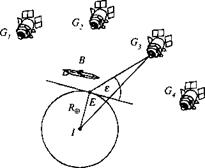
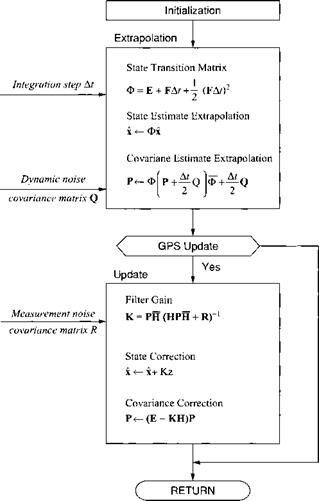
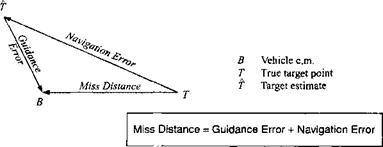



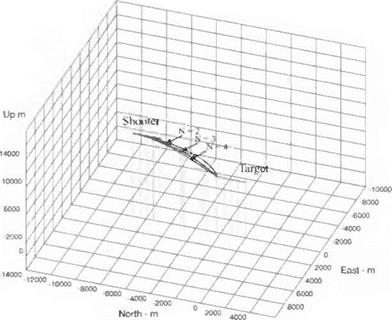
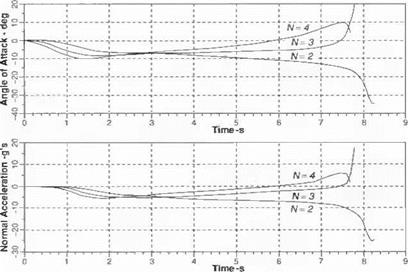
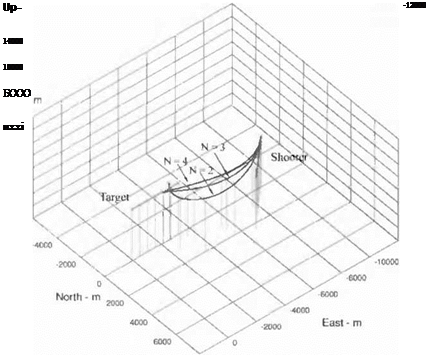





 £ si
£ si